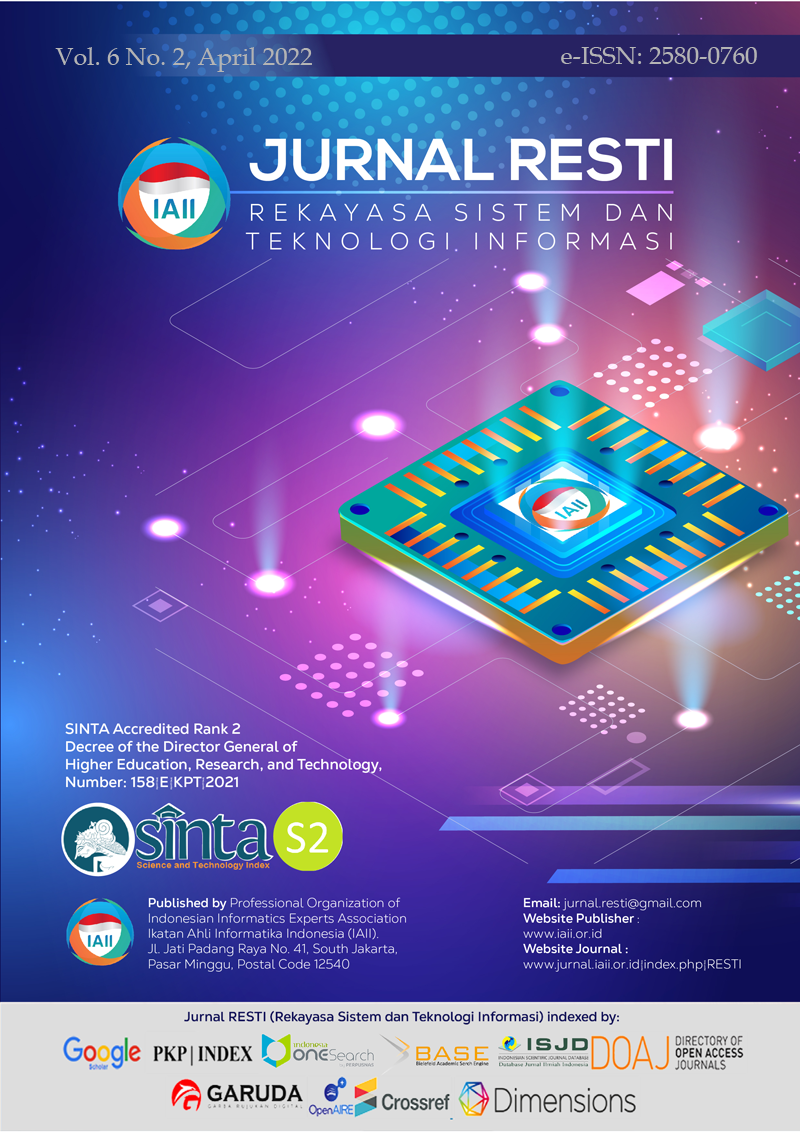Designing an Ethereum-based Blockchain for Tuition Payment System using Smart Contract Service
Abstract
The security and disclosure of information in online transaction data remain a sensitive subject until this day. Whenever data collection from a transaction process is accessible over the internet system, certain parties may misuse any one of these data. Blockchain technology, which includes the use of smart contracts, is thought to overcome this problem due to the blockchain's decentralized and distributed nature. Blockchain allows transaction data to be accessed openly and transparently while securely protected by hashing encryption owned by intelligent contracts. This enables users to have detailed access privileges to each transaction's data. The development of smart contracts will be carried out in the production of microservices payment gateways based on decentralized apps (DApps) on the Ethereum blockchain in this research, with the payment gateway generated being used in the tuition payment process. The Truffle framework and the Metamask wallet will be used to assist the Ethereum payment process during the DApps development process. Testing the functionality of each intelligent contract feature reveals that the payment system can be utilized effectively and that there are no issues that cause transaction failures.
Downloads
References
Y. Hu et al., “A Delay-Tolerant Payment Scheme Based on the Ethereum Blockchain,” IEEE Access, vol. 7, Mar. 2019, doi: 10.1109/ACCESS.2019.2903271.
J. Zhang, A. Xu, M. Li, X. Huang, N. Xue, and Q. Sheng, “A Blockchain Based Micro Payment System for Smart Devices,” Int. J. Des. Anal. TOOLS INTERGRATED CIRCUITS Syst., 2016, [Online]. Available: http://www.ti.com/lit/ml/slyb214/slyb214.pdf.
D. D. Putri and M. H. Fahrozi, “Upaya Pencegahan Kebocoran Data Konsumen Melalui Pengesahan RUU Perlindungan Data Pribadi (Studi Kasus E-Commerce Bhinneka.com),” in National Conference On Law Studies, 2020, pp. 978–979.
M. D. K. Perdani, W. Widyawan, and P. I. Santosa, “Blockchain untuk Keamanan Transaksi Elektronik Perusahaan Financial Technology (Studi Kasus pada PT XYZ),” Open J. Syst. Semnasteknomedia Online, vol. 6, no. 1, pp. 7–12, 2018, [Online]. Available: https://www.ojs.amikom.ac.id/index.php/semnasteknomedia/article/view/2132/1936.
A. A. N. D. H. Kesuma, I. N. P. Budiartha, and P. A. S. Wesna, “Perlindungan Hukum Terhadap Keamanan Data,” J. Prefer. Huk., vol. 2, no. 2, pp. 411–416, 2021.
D. Godfrey-welch, R. Lagrois, J. Law, and R. S. Anderwald, “Blockchain in Payment Card Systems,” J. SMU Data Sci. Rev., vol. 1, no. 1, p. 3, 2018, [Online]. Available: https://scholar.smu.edu/datasciencereviewhttp://digitalrepository.smu.edu.Availableat:https://scholar.smu.edu/datasciencereview/vol1/iss1/3.
S. I. Kim and S. H. Kim, “E-commerce payment model using blockchain,” J. Ambient Intell. Humaniz. Comput., no. 2008, 2020, doi: 10.1007/s12652-020-02519-5.
U. Rahardja, Q. Aini, M. Yusup, and A. Edliyanti, “Penerapan Teknologi Blockchain Sebagai Media Pengamanan Proses Transaksi E-Commerce,” CESS (Journal Comput. Eng. Syst. Sci., vol. 5, no. 1, p. 28, 2020, doi: 10.24114/cess.v5i1.14893.
D. Kaid, M. M. Eljazzar, and I. Member, “Applying Blockchain to Automate Installments Payment between Supply Chain Parties,” 2018 14th Int. Comput. Eng. Conf., pp. 231–235, 2008, doi: 10.1109/ICENCO.2018.8636131.
A. A. Monrat, O. Schelén, and K. Andersson, “A survey of blockchain from the perspectives of applications, challenges, and opportunities,” IEEE Access, vol. 7, pp. 117134–117151, 2019, doi: 10.1109/ACCESS.2019.2936094.
F. Aprialim, Adnan, and A. W. Paundu, “Penerapan Blockchain dengan Integrasi Smart Contract pada Sistem Crowdfunding,” J. RESTI (Rekayasa Sist. dan Teknol. Informasi), vol. 5, no. 1, pp. 148–154, 2021, doi: 10.29207/resti.v5i1.2613.
Annisya and E. Haryatmi, “Implementasi Teknologi Blockchain Proof of Work Pada Penelusuran Supply Chain Produk Komputer,” J. RESTI (Rekayasa Sist. dan Teknol. Informasi), vol. 5, no. 3, pp. 446–455, 2021, doi: 10.29207/resti.v5i3.3068.
G. Dharma Putra and S. Sumaryono, “Rancang Bangun Identity and Access Management IoT Berbasis KSI dan Permissioned Blockchain,” J. Nas. Tek. Elektro dan Teknol. Inf., vol. 7, no. 4, 2018, doi: http://dx.doi.org/10.22146/jnteti.v7i4.455.
Lathifah Arief, T. A. Sundara, and Heru Saputra, “Studi Perbandingan Jaringan Blockchain sebagai Platform Sistem Rating,” J. RESTI (Rekayasa Sist. dan Teknol. Informasi), vol. 5, no. 4, pp. 827–836, 2021, doi: 10.29207/resti.v5i4.2588.
M. Pilkington, “Blockchain technology: Principles and applications. In F. X. Olleros, & M. Zhegu (Eds.),” Res. Handb. Digit. Transform., pp. 225–253, 2016, doi: https://doi.org/10.4337/9781784717766.00019.
L. Aniello, R. Baldoni, E. Gaetani, F. Lombardi, A. Margheri, and V. Sassone, “A Prototype Evaluation of a Tamper-Resistant High Performance Blockchain-Based Transaction Log for a Distributed Database,” Proc. - 2017 13th Eur. Dependable Comput. Conf. EDCC 2017, pp. 151–154, 2017, doi: 10.1109/EDCC.2017.31.
S. Damai, K. Hu, H. Novianus Palit, and A. Handojo, “Implementasi Blockchain: Studi Kasus e-Voting,” J. INFRA, vol. 7, 2019, [Online]. Available: https://publication.petra.ac.id/index.php/teknik-informatika/article/view/8069.
A. Susanto, “Implementation of Smart Contracts Ethereum Blockchain in Web-Based Electronic Voting (e-voting),” J. Inf. Technol., vol. 18, no. 1, p. 56, 2020, doi: 10.26623/transformatika.v18i1.1779.
Z. Zheng, S. Xie, H. Dai, X. Chen, and H. Wang, “An Overview of Blockchain Technology: Architecture, Consensus, and Future Trends,” Proc. - 2017 IEEE 6th Int. Congr. Big Data, BigData Congr. 2017, pp. 557–564, 2017, doi: 10.1109/BigDataCongress.2017.85.
A. Argani and W. Taraka, “Pemanfaatan Teknologi Blockchain Untuk Mengoptimalkan Keamanan Sertifikat Pada Perguruan Tinggi,” ADI Bisnis Digit. Interdisiplin J., vol. 1, pp. 10–21, 2020, doi: https://doi.org/10.34306/abdi.v1i1.121.
A. K. Yadav and R. K. Bajpa, “KYC Optimization using Blockchain Smart Contract Technology,” Int. J. Innov. Res. Appl. Sci. Eng., vol. 4, no. 3, pp. 669–674, 2020, doi: 10.29027/ijirase.v4.i3.2020.669-674.
Copyright (c) 2022 Jurnal RESTI (Rekayasa Sistem dan Teknologi Informasi)

This work is licensed under a Creative Commons Attribution 4.0 International License.
Copyright in each article belongs to the author
- The author acknowledges that the RESTI Journal (System Engineering and Information Technology) is the first publisher to publish with a license Creative Commons Attribution 4.0 International License.
- Authors can enter writing separately, arrange the non-exclusive distribution of manuscripts that have been published in this journal into other versions (eg sent to the author's institutional repository, publication in a book, etc.), by acknowledging that the manuscript has been published for the first time in the RESTI (Rekayasa Sistem dan Teknologi Informasi) journal ;







